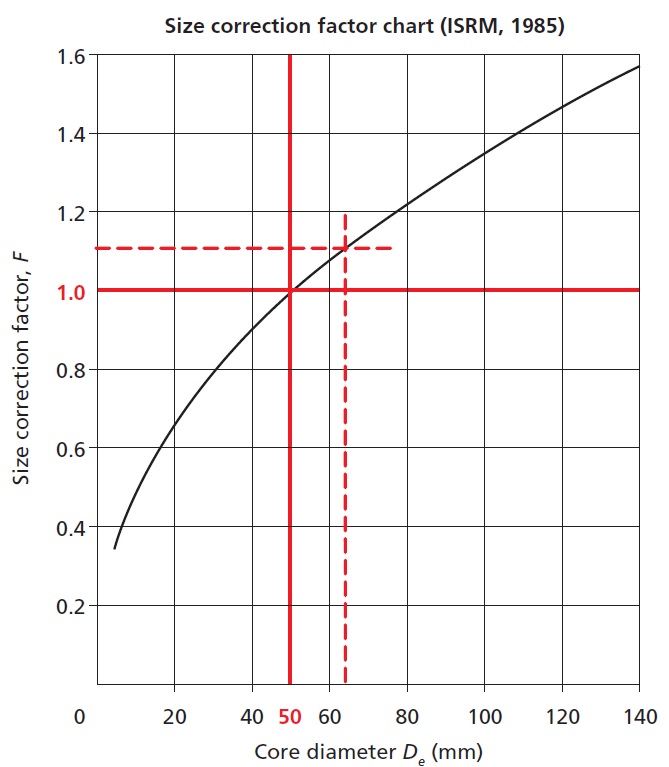Point Load Test (PLT)

Uniaxial strength calculated using the Point Load Test (PLT)
The correlation between the Is index, obtained from the Point Load Test – PLT test and the uniaxial compressive strength of a rock, is for 50 mm diameter cores. For specimens with a different diameter, a size correction must be applied to obtain the corrected Point Load Strength Index, Is(50). The size correction must be applied using the formula:
Is(50) = F × Is
where F is a size correction factor, which can be obtained from the chart in this box or from the expression (with De in mm):
F = (De/50)0.45
which can be applied irrespective of the degree of anisotropy of the specimen and the loading direction (ISRM, 1985).
Once the mean value of Is(50) for the sample tested is calculated, after excluding the two highest and lowest values from 10 or more valid tests, it can be used to predict the uniaxial compressive strength expected of the material in that direction. The relationship between σc and the point load strength index can be expressed as:
σc = f × Is(50)
where f is the conversion factor, ranging in most cases between 25 and 20 depending on the type of rock (higher for hard, strong rocks and lower for soft rocks), with even lower values for some shales and mudstones; however, f can vary between 15 and 50, especially for anisotropic rocks (ISRM, 1985).
The PLT’s accuracy in predicting the uniaxial compressive strength depends on the ratio between the σc and the tensile strength. For most brittle rocks, the ratio is approximately 10. For soft mudstones and claystones, however, the ratio may be closer to 5. This implies that Point Load Test – PLT results might have to be interpreted differently for the weakest rocks. The accuracy of the estimate also depends on the number of tests conducted.
Point load strength often replaces uniaxial compressive strength, σc, when there is sufficient confidence in the relationship between PLT and σc obtained from direct tests of UCS, since when properly conducted PLT is as reliable and much quicker to measure.
Example:
A series of diametral tests are conducted on cores with a diameter D = 6.5 cm, and gave the following values for Is = P/D2e (MN/m2): 2.1, 2.4, 1.7, 1.9, 2.2, 1.6, 2.3, 2.1, 1.8, 1.9. From the chart below, the size correction factor for D = 65 mm is F = 1.125, and thus the corrected values for Is(50) = P/D2e (MN/m2) are: 2.362, 2.7, 1.912, 2.137, 2.475, 1.8, 2.587, 2.362, 2.025, 2.137. The Is(50) mean value, once the two highest and lowest values have been excluded, is 2.25, and this value can be entered in the expression for estimating the uniaxial compressive strength, σc = f × Is(50). If a value of 23–24 is assumed for the conversion factor f, because the rock tested is a hard, fresh material, then σc = 52–54 MN/m2 or MPa.

